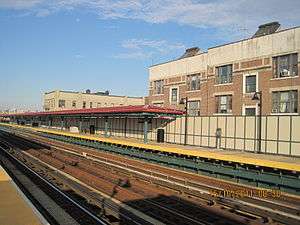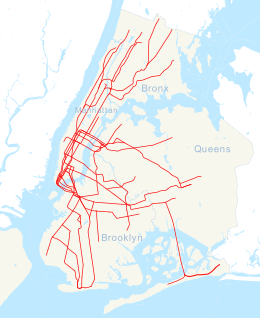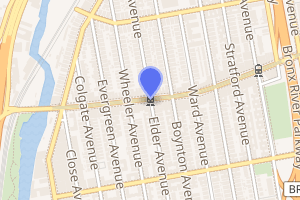Elder Avenue station
Elder Avenue is a local station on the IRT Pelham Line of the New York City Subway. Served by the 6 train at all times, it is located at the intersection of Elder Avenue and Westchester Avenue in the Soundview neighborhood of the Bronx.
Elder Avenue | |||||||
|---|---|---|---|---|---|---|---|
 Station after rehab in 2011 | |||||||
| Station statistics | |||||||
| Address | Elder Avenue & Westchester Avenue Bronx, NY 10472 | ||||||
| Borough | The Bronx | ||||||
| Locale | Soundview | ||||||
| Coordinates | 40.828553°N 73.879194°W | ||||||
| Division | A (IRT) | ||||||
| Line | IRT Pelham Line | ||||||
| Services | 6 | ||||||
| Transit connections | |||||||
| Structure | Elevated | ||||||
| Platforms | 2 side platforms | ||||||
| Tracks | 3 | ||||||
| Other information | |||||||
| Opened | May 30, 1920 | ||||||
| Rebuilt | February 28, 2011 to October 16, 2011 | ||||||
| Station code | 369[1] | ||||||
| Opposite-direction transfer available | Yes | ||||||
| Traffic | |||||||
| Passengers (2019) | 1,996,492[2] | ||||||
| Rank | 236 out of 424[2] | ||||||
| Station succession | |||||||
| Next north | Morrison Avenue–Soundview: 6 | ||||||
| Next south | Whitlock Avenue: 6 | ||||||
| |||||||
| |||||||
| |||||||
History
Elder Avenue station opened on May 30, 1920 as the Pelham Line was extended to East 177th Street from Hunts Point Avenue.[3][4][5] The construction of the Pelham Line was part of the Dual Contracts, signed on March 19, 1913 and also known as the Dual Subway System.[6] The Pelham Line was built as a branch of the Lexington Avenue Line running northeast via 138th Street, Southern Boulevard and Westchester Avenue.[7] Initially, service to the extension was served by a shuttle service operating with elevated cars. Passengers transferred to the shuttle at Hunts Point Avenue.[8]
Station layout
| P Platform level |
Side platform | |
| Southbound local | ← | |
| Peak-direction express | ← | |
| Northbound local | | |
| Side platform | ||
| M | Mezzanine | Fare control, station agent, MetroCard machines |
| G | Street level | Exit/entrance |
This elevated station has three tracks and two side platforms. The center track is used by the weekday peak direction <6> express service.[9] Both platforms have beige windscreens and red canopies with green frames and support columns at the center and black waist-high steel fences at either ends.[10] The station name plates are in the standard black with white lettering that covered up the original IRT style mosaic signs.[11]
Exits
The station's only entrance/exit is an elevated station house beneath the tracks.[12] Inside the turnstile bank, there are two staircases to each platform at the center and a waiting area that allows a free transfer between directions. Outside fare control, there is a token booth and two staircases going down to the southwest and northeast corner of Elder and Westchester Avenues.[13]
References
- "Station Developers' Information". Metropolitan Transportation Authority. Retrieved June 13, 2017.
- "Facts and Figures: Annual Subway Ridership 2014–2019". Metropolitan Transportation Authority. 2020. Retrieved May 26, 2020.
- "Bronx Subway Extension Opened" (PDF). New York Times. May 28, 1920. Retrieved January 25, 2016.
- Brooklyn Daily Eagle Almanac. Brooklyn Daily Eagle. 1922. p. 372.
- Annual Report for the Year Ending June 30, 1920. Interborough Rapid Transit Company. 1920. pp. 5, 13.
- nycsubway.org—The Dual Contracts
- "The Dual System of Rapid Transit (1912)". www.nycsubway.org. Retrieved March 25, 2014.
- Cunningham, Joseph; DeHart, Leonard O. (1993). A History of the New York City Subway System. J. Schmidt, R. Giglio, and K. Lang. p. 48.
- Dougherty, Peter (2006) [2002]. Tracks of the New York City Subway 2006 (3rd ed.). Dougherty. OCLC 49777633 – via Google Books.
- Cox, Jeremiah (December 6, 2004). "Elder Avenue (6) has boring blue canopies on each platform". subwaynut.com. Retrieved April 2, 2018.
- Cox, Jeremiah (December 6, 2004). "A boring metal platform sign at Elder Avenue (6)". subwaynut.com. Retrieved April 2, 2018.
- Westerfield, Al (2010). "Mezzanine viewed from street". nycsubway.org. Retrieved April 2, 2018.
- "Elder Avenue Neighborhood Map" (PDF). new.mta.info. Metropolitan Transportation Authority. April 2018. Retrieved February 28, 2019.
External links
| Wikimedia Commons has media related to Elder Avenue (IRT Pelham Line). |
- nycsubway.org – IRT Pelham Line: Elder Avenue
- Station Reporter – 6 train
- The Subway Nut – Elder Avenue Pictures
- Elder Avenue entrance from Google Maps Street View
- Platforms from Google Maps Street View



